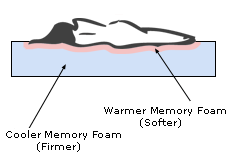High-density Memory Foam Mattress
Contents
We’ve all seen the ads for memory foam mattresses. We’ve also seen the price tag. What makes them so comfortable that some people will go as far as collecting viscoelastic foam samples in order to build their very own bed? And is the premium mattress price justified?
Density, firmness and heat responsiveness are what make a memory foam mattress supportive and comfortable. Each foam has a unique recipe that gives it its own feel, longevity and performance. So what is the recipe of Tempurpedic visco foam mattresses?
Being one of the best-known brands on the market, there is a wealth of information on Tempurpedic mattress technology. Reading about it gives you invaluable tips for choosing a memory mattress, be it the leading brand or not. For example:
The Top Factor In Memory Foam Mattress Success
Memory foam density ranges from 2.5lb to 5.9lb. (density is measured in pounds per cubic foot). The tempurpedic foam used in memory mattresses is 5.34 lb which means that a cube of Tempur material, one foot in each direction, weighs a whopping 5.34lb. But how does this relate to comfort and support?
Generally speaking, mattresses made of the higher density foam are much better quality and perform better over their expected lifetime. Here’s why.
High-Density Foam Has More Body And Longer Memory
In high-density foam, there are billions of small, open cells (bubbles with holes in them), tightly packed together. When you lie down on a high-density foam mattress, air flows slowly between the bubbles giving it time to gently cradle the natural hollows of your body, distribute your weight, and relieve pressure.
- High-density foam has more body (thanks to the denser material), hence, it provides more cushion and better support. It conforms precisely to your body and slowly regains its original shape when you move, just like the hand imprint you may have seen on TV recovers after a few seconds.
- High-density foams also have a longer memory. The general consensus seems to be that longer recovery from a compressed state makes a visco memory mattress more supportive. High-density foam also softens more slowly in response to body heat making it feel more gentle.
- You don’t sink right through a high-density memory foam mattress nor do you risk bottoming out. The extremely dense cell structure in foam mattresses by top manufacturers supports you well without wearing out in a few years’ time. Its firmness keeps you up as well.
- High-density visco foam is also more expensive to make because more raw material called resin, rather than air goes into making the stuff. This is one of the things which explains why a top brand memory foam mattress is so expensive.
 Over the past few years manufacturers in the US and the UK (see Ergoflex’s memory foam mattress selection) have come up with good quality memory foam products so there’s a wider choice on the market than just one brand.
Over the past few years manufacturers in the US and the UK (see Ergoflex’s memory foam mattress selection) have come up with good quality memory foam products so there’s a wider choice on the market than just one brand.
The ability to change firmness actually improves support and comfort. The firmness and density of the cooler foam deeper in the bed hold you up. But increased support also comes from the foam’s heat responsiveness. The visco elastic foam bed or topper softens at body temperature and makes up to 30% more body contact, thus improving weight distribution over a wider area.
Generally speaking
- Higher-density memory foam toppers are firmer because of the better quality resin used to make them. But this may not always be the case. You may come across the firm, low-density toppers.
- High density visco foam like the one used to make foam beds perform better as long as their firmness reacts to body temperature and adjusts in order to improve weight distribution and relieve pressure.

